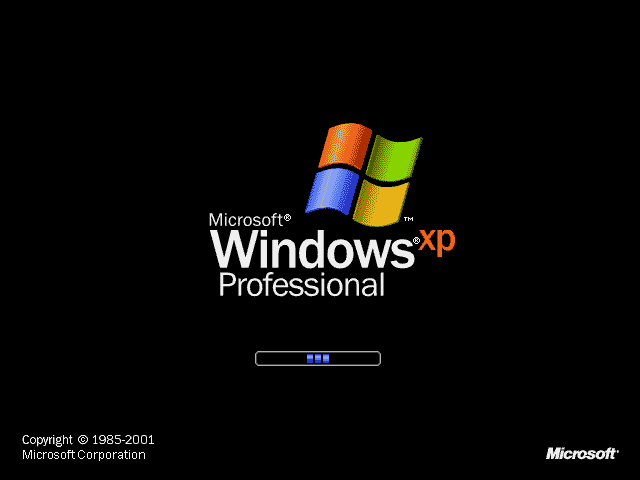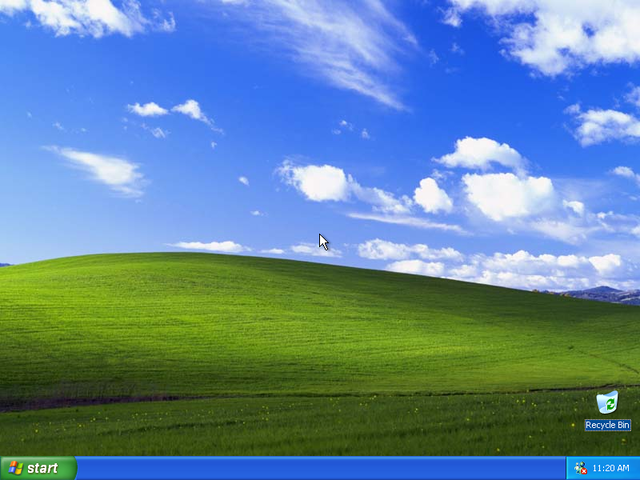
Windows XP's retail release was October 25, 2001, ten years ago today. Though no longer readily available to buy, it continues to cast a long shadow over the PC industry: even now, a slim majority of desktop users are still using the operating system.
Windows XP didn't boast exciting new features or radical changes, but it was nonetheless a pivotal moment in Microsoft's history. It was Microsoft's first mass-market operating system in the Windows NT family. It was also Microsoft's first consumer operating system that offered true protected memory, preemptive multitasking, multiprocessor support, and multiuser security.
The transition to pure 32-bit, modern operating systems was a slow and painful one. Though Windows NT 3.1 hit the market in 1993, its hardware demands and software incompatibility made it a niche operating system. Windows 3.1 and 3.11 both introduced small amounts of 32-bit code, and the Windows 95 family was a complex hybrid of 16-bit and 32-bit code. It wasn't until Windows XP that Windows NT was both compatible enough—most applications having been updated to use Microsoft's Win32 API—and sufficiently light on resources.
In the history of PC operating systems, Windows XP stands alone. Even Windows 95, though a landmark at its release, was a distant memory by 2005. No previous PC operating system has demonstrated such longevity, and it's unlikely that any future operating system will. Nor is its market share dominance ever likely to be replicated; at its peak, Windows XP was used by more than 80 percent of desktop users.
The success was remarkable for an operating system whose reception was initially quite muted. In the wake of the September 11th attacks, the media blitz that Microsoft planned for the operating system was toned down; instead of arriving with great fanfare, it slouched onto the market. Retail sales, though never a major way of delivering operating systems to end users, were sluggish, with the operating system selling at a far slower rate than Windows 98 had done three years previously.
It faced tough competition from Microsoft's other operating systems. Windows 2000, released less than two years prior, had won plaudits with its marriage of Windows NT's traditional stability and security to creature comforts like USB support, reliable plug-and-play, and widespread driver support, and was widely adopted in businesses. For Windows 2000 users, Windows XP was only a minor update: it had a spruced up user interface with the brightly colored Luna theme, an updated Start menu, and lots of little bits and pieces like a firewall, UPnP, System Restore, and ClearType. Indeed, many professionals and, for want of a better term, nerds, were turned off by the Luna theme, with its detractors dismissing Windows XP as a Fisher-Price operating system.

For home users using Windows 95-family operating systems, Windows XP had much more to offer, thanks to its substantially greater stability and security, especially once Service Pack 2 was released. But even there, users didn't leap immediately. Windows XP's hardware demands, though modest by today's standards, were steeper than those of the Windows 95 family, and in its early days at least, neither Windows XP's driver support nor performance could match those of its technologically inferior sibling. Gamers, in particular, were vocal in their criticism of Windows XP, and many vowed to stick with Windows 98SE indefinitely.
In the first year of Windows XP's availability, Microsoft had to work to persuade even enterprises to ditch Windows 95, in spite of its near complete unsuitability to enterprise computing.
In the end, none of the objections mattered. Time made Windows XP a success. Computers got faster, rendering its hardware demands first ubiquitous, and then later in its life, almost laughable. Driver support grew, and driver performance improved. Instead of being a heavyweight alternative to use if you had the resources and you could be sure that all your hardware and software would work with it, it became the obvious choice of system software. The explosion in Internet usage, and the focus on system security, made continued use of the Windows 95 family untenable. Windows XP was therefore the only choice for most desktop users, and within a few years of its release, most Windows 95, Windows 98, Windows NT 4, and Windows 2000 users had made the switch.
The long life of Windows XP
Over the course of its life, Microsoft made Windows XP a much better operating system. Service Pack 2, released in 2004, was a major overhaul of the operating system. It made the software better able to handle modern systems, with improved WiFi support and a native Bluetooth stack, and made it far more secure. The firewall was enabled by default, the bundled Internet Explorer 6 gained the "gold bar" popup blocker and ActiveX security feature, and for hardware that supported it, Data Execution Protection made it more difficult to exploit software flaws.
Microsoft also produced a number of variants of the base operating system. The two major ones were Windows XP Media Center Edition and Windows XP Tablet Edition. These were efforts to push Windows into new kinds of market—the TV-connected home theater PC, and the pen-powered tablet—though neither met with any great commercial success, and for Windows Vista, their features were rolled into the core product rather than shipping as standalone versions.
But in many ways, the thing that cemented Windows XP's status wasn't Windows XP itself: it was the lack of any successor. Microsoft's Longhorn project, an ambitious plan to radically rework Windows, with an all-new set of APIs and a database-like filesystem, was delayed and ultimately abandoned entirely. Windows Vista, a massively scaled back, more conservative release, eventually arrived in 2006, but by this time Windows XP had become so dominant that users, particularly business users, didn't want a new operating system. That Windows Vista had trouble in its early days, thanks to its steeper hardware demands, its polarizing appearance, and display driver issues—mirroring, in many ways, Windows XP's own introduction—just served to entrench Windows XP further. Business users stuck with Windows XP, and Windows Vista struggled to ever make a serious dent in its predecessor's market share, peaking at just 19 percent in the final days before Windows 7's release.
Had Windows Longhorn been more successful, and had Windows Vista arrived sooner, Windows XP's market share dominance would never have been achieved. Windows 7, though well-received and widely liked, will be lucky to hit 50 percent market share before its replacement, Windows 8, hits the market (assuming Microsoft manages to avoid any development disasters). With a new operating system coming out every two to three years, which is Microsoft's plan, there simply isn't enough time to amass that much market share.
Long in the tooth it may be, but Windows XP still basically works. Regardless of the circumstances that led to its dominance and longevity, the fact that it remains usable so long after release is remarkable. Windows XP was robust enough, modern enough, well-rounded enough, and usable enough to support this extended life. Not only was Windows XP the first (and only) PC operating system that lasted ten years: it was the first PC operating system that was good enough to last ten years. Windows 98 didn't have the security or stability; Windows 2000 didn't have the security or comfort; Mac OS X 10.1 didn't have the performance, the richness of APIs, or the hardware support.
The downside of longevity
As much as businesses have enjoyed the ability to standardize on one operating system for a decade, the effect of Windows XP's long life and massive market share has its downsides. Windows XP is today a very tired platform, one that hasn't kept up with modern developments. Installing it onto systems with new RAID or SATA controllers is a miserable experience. Installing it on systems without optical drives is also troublesome. Though Service Pack 2 took steps to improve security, it still falls a long way short of Windows Vista and Windows 7 in that regard, thanks to newer features such as address space layout randomization and User Account Control. The technology it uses is dated; Windows 7 and Mac OS X both use GPUs' powerful 3D capabilities to accelerate their user interfaces (to a greater or lesser extent). Windows XP does not. Windows XP also lacks a true 64-bit version; though a Windows XP for x86-64 processors was released, it was actually a rebranded version of Windows Server 2003, a decision which caused various compatibility issues. Windows Vista and Windows 7, in contrast, both have mainstream, well-supported 64-bit versions.
New versions of Windows offer value to developers, too. Direct3D 10, for example, only supports Windows Vista and Windows 7; it's not available on Windows XP. The continued widespread usage of the old operating system makes it much harder for developers to depend on these new features: every time they do, they rule out the ability to sell to half of all current Windows users, and that's a bitter pill to swallow. More aggressive migration away from Windows XP would enable the development of better third-party applications.
Given current trends, Windows 7 will overtake XP within the next year, with many businesses now moving away from the decade-old OS in earnest. Not all—there are still companies and governments rolling out Windows XP on new hardware—but the tide has turned. Windows XP, with its weaker security and inferior support for modern hardware, is now becoming a liability; Windows 7 is good enough for business and an eminently worthy successor, in a way that Windows Vista was never felt to be.
Nonetheless, it will be several years before developers and administrators can put Windows XP behind them. Its support is due to end on April 8th, 2014, and while that date is still some years off, it's all but inevitable that there will be organizations still using the operating system right up to the cut-off. Beyond the support cut-off, companies will still be allowed to downgrade their volume licenses, but they won't receive any further security patches if they do.
When Microsoft wanted to stop OEM preinstallations of Windows XP in 2007, there was a widespread backlash against the decision. It wouldn't be surprising to see a campaign of some kind to extend support for the operating system, and no doubt there will be some companies claiming that they somehow didn't have enough time to phase out Windows XP. Redmond did extend the length of time that OEMs could ship systems with Windows XP preinstalled in response to customer demands, but it's hard to see the company lengthening the operating system's support period beyond the cut-off.
Ten years is a good run for any operating system, but it really is time to move on. Windows 7 is more than just a solid replacement: it is a better piece of software, and it's a much better match for the software and hardware of today. Being usable for ten years is quite an achievement, but the stagnation it caused hurts, and is causing increased costs for administrators and developers alike. As incredible as Windows XP's longevity has been, it's a one-off. Several factors—the 32-bit transition, the Longhorn fiasco, even the lack of competition resulting from Apple's own Mac OS X transition—conspired to make Windows XP's position in the market unique. We should not want this situation to recur: Windows XP needs to be not only the first ten-year operating system; it also needs to be the last.
Listing image by Photograph by www.guidebookgallery.org
reader comments
252